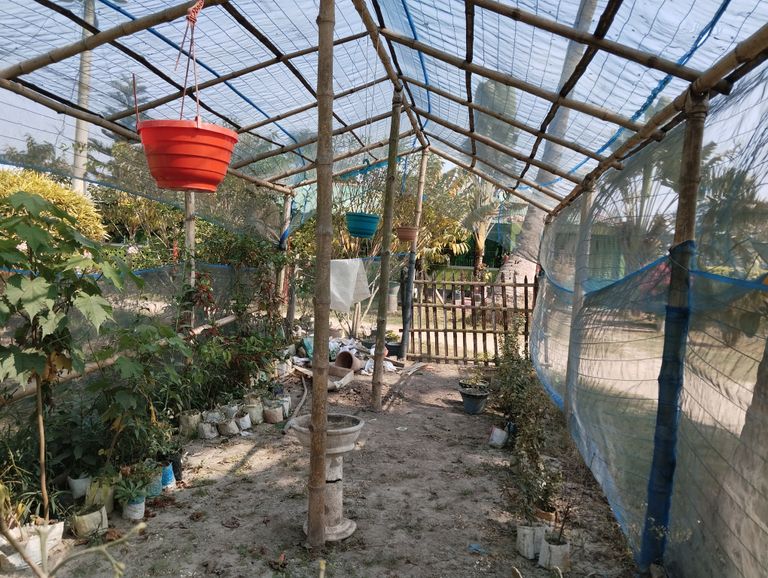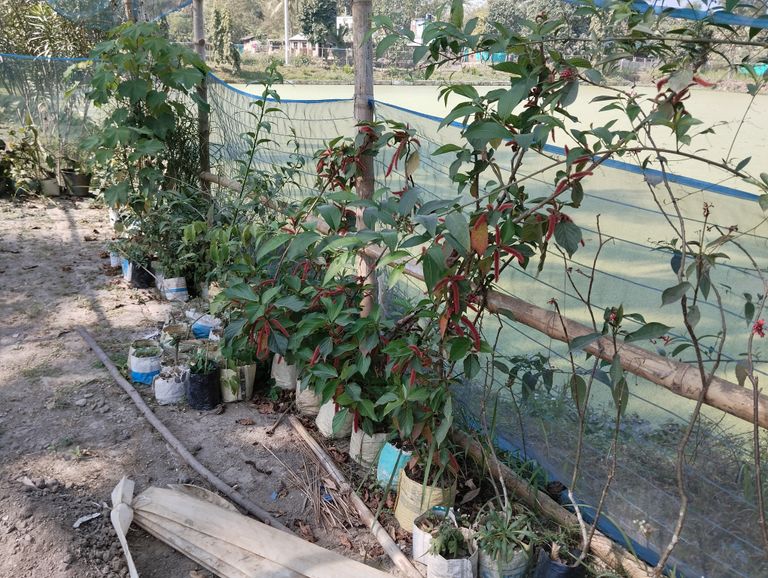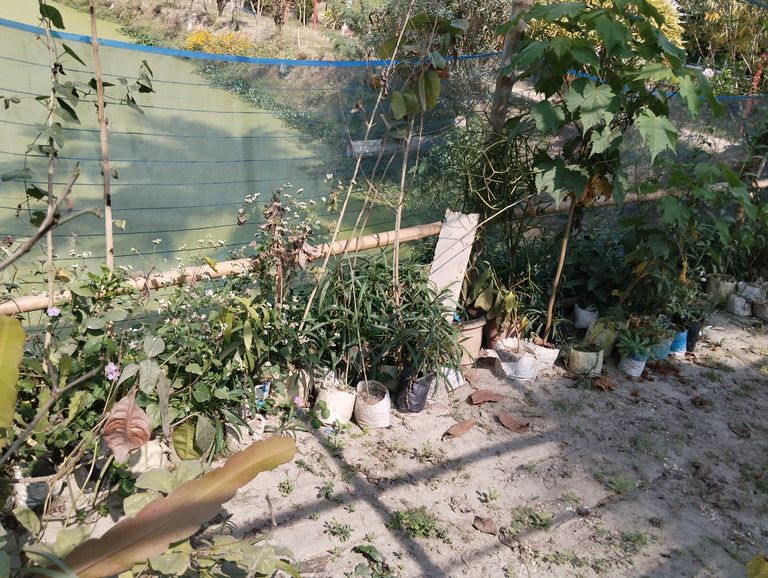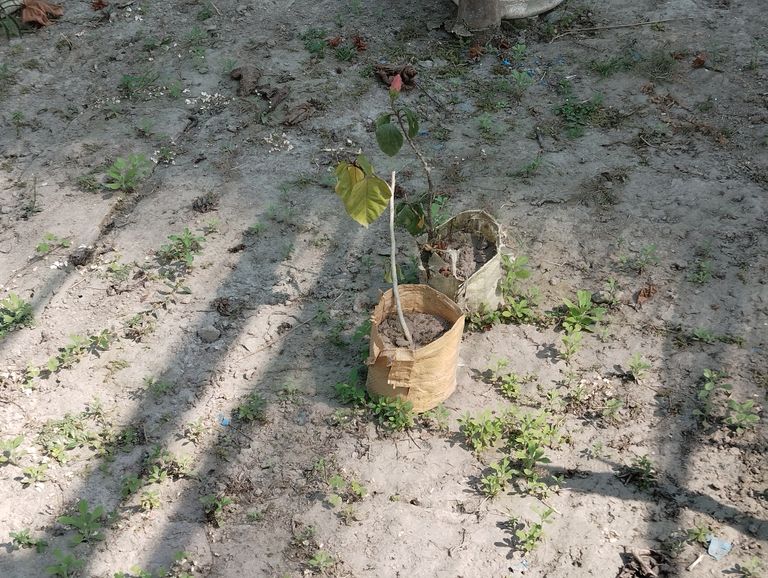
Proper Method of Planting Flower Seedlings in a Nursery.
Creating a nursery with healthy and vibrant flowers requires careful planning and execution. Proper planting techniques ensure the growth of strong seedlings that can thrive in gardens or commercial flower farms. In this guide, we will discuss the essential steps to plant flower seedlings correctly in a nursery.
- Choosing the Right Location
Selecting an appropriate location for the nursery is crucial for the healthy growth of flower seedlings. Consider the following factors:
Sunlight: Most flowering plants require 4-6 hours of direct sunlight.
Soil Quality: Choose well-drained, nutrient-rich soil with good moisture retention.
Protection: The nursery should be protected from strong winds, heavy rain, and extreme temperatures.
- Preparing the Nursery Bed
A well-prepared nursery bed ensures healthy root development and optimal growth. Follow these steps:
Soil Preparation: Loosen the soil to a depth of 10-15 cm and remove weeds, rocks, and debris.
Organic Matter: Mix compost or well-rotted manure to enhance soil fertility.
Drainage: Ensure proper drainage to prevent waterlogging, which can cause root rot.
- Selecting and Preparing Seedlings
Choosing high-quality seedlings is essential for a successful nursery. Consider these aspects:
Healthy Seedlings: Select disease-free, pest-free seedlings with strong roots and green leaves.
Hardening Off: Gradually expose seedlings to outdoor conditions to strengthen them before transplanting.
Root Treatment: If needed, dip the roots in a mild fungicide solution to prevent infections.
- Planting the Seedlings
The correct planting method ensures healthy establishment and growth. Follow these steps:
Spacing: Maintain proper spacing based on the plant species to allow for air circulation and growth.
Planting Depth: Dig a hole slightly larger than the root ball and place the seedling at the same depth as it was in the seed tray or pot.
Soil Covering: Gently cover the roots with soil and press lightly to remove air pockets.
Watering: Water the seedlings immediately after planting to help settle the soil around the roots.
- Providing Proper Care
After planting, proper care is necessary for the seedlings to grow into healthy plants. Consider the following:
Regular Watering: Keep the soil consistently moist but avoid overwatering.
Mulching: Apply a thin layer of organic mulch to retain moisture and prevent weed growth.
Fertilization: Use a balanced fertilizer as per the plant's requirements.
Pest and Disease Control: Monitor for pests and diseases and take appropriate action when necessary.
- Transplanting to the Main Garden
Once the seedlings are strong enough, they can be transplanted to the main garden. Follow these steps:
Choose the Right Time: Transplant in the early morning or late afternoon to reduce stress.
Watering Before Transplanting: Water the seedlings a few hours before moving them.
Gentle Handling: Carefully remove the seedlings without damaging the roots.
Proper Planting: Place them in the new location at the right depth and firm the soil around them.
By following these proper planting methods, you can establish a thriving nursery filled with beautiful, healthy flowers. With careful attention and maintenance, your nursery will be a source of joy and beauty for years to come. I've created a detailed blog on planting flower seedlings in a nursery. Let me know if you need any modifications or additional details.

Flower Diseases and Pests: A Comprehensive Guide
Flowers add beauty to our surroundings, but they are also vulnerable to various diseases and pests. Proper identification and management of these problems are essential for maintaining healthy and vibrant blooms. This guide will help you understand common flower diseases and pests, along with effective control measures.
Common Flower Diseases
- Powdery Mildew
Cause: Fungal infection caused by species of Erysiphales. Symptoms: White, powdery patches on leaves, stems, and buds. Prevention & Treatment:
Ensure proper air circulation by spacing plants adequately.
Avoid overhead watering.
Use fungicidal sprays or organic treatments like neem oil.
- Botrytis Blight (Gray Mold)
Cause: Fungus Botrytis cinerea. Symptoms: Brown or gray fuzzy mold on petals, leaves, and stems. Prevention & Treatment:
Remove infected plant parts promptly.
Maintain dry conditions around flowers.
Apply copper-based fungicides.
- Black Spot
Cause: Fungus Diplocarpon rosae (common in roses). Symptoms: Circular black spots on leaves, leading to yellowing and defoliation. Prevention & Treatment:
Prune affected leaves and dispose of them properly.
Apply fungicides like sulfur or copper-based products.
Water plants at the base to avoid leaf moisture.
- Rust Disease
Cause: Fungal pathogens (Pucciniales group). Symptoms: Orange or yellow pustules on the underside of leaves. Prevention & Treatment:
Remove infected leaves.
Avoid excessive humidity around plants.
Use sulfur-based fungicides.
- Root Rot
Cause: Soilborne fungi like Phytophthora and Pythium. Symptoms: Wilting, yellowing leaves, and mushy roots. Prevention & Treatment:
Ensure well-draining soil.
Avoid overwatering.
Use fungicides containing copper or phosphorous acid.
Common Flower Pests
- Aphids
Description: Tiny, soft-bodied insects that suck plant sap. Damage: Curling leaves, sticky honeydew, and weakened plants. Control Measures:
Spray plants with a strong stream of water.
Use neem oil or insecticidal soap.
Introduce natural predators like ladybugs.
- Spider Mites
Description: Microscopic arachnids that cause stippling on leaves. Damage: Yellowing leaves, fine webbing, and leaf drop. Control Measures:
Regularly mist plants to maintain humidity.
Use neem oil or miticides.
Encourage natural predators like lacewings.
- Whiteflies
Description: Small, white, moth-like insects that cluster under leaves. Damage: Sap-sucking, leading to yellowing leaves and stunted growth. Control Measures:
Use yellow sticky traps.
Apply insecticidal soap or neem oil.
Encourage beneficial insects like parasitic wasps.
- Thrips
Description: Tiny, slender insects that feed on flower petals and leaves. Damage: Deformed flowers, discolored petals, and stippled leaves. Control Measures:
Remove affected flowers and buds.
Use neem oil or spinosad-based insecticides.
Introduce predatory insects like pirate bugs.
- Caterpillars
Description: Larval stage of moths and butterflies. Damage: Chewed leaves and flowers. Control Measures:
Handpick caterpillars from plants.
Use biological controls like Bacillus thuringiensis (Bt).
Encourage birds in the garden to feed on larvae.
Integrated Pest and Disease Management (IPM)
To ensure long-term health and vitality of flowers, an integrated approach combining multiple control methods is most effective.
Preventative Measures
Choose disease-resistant flower varieties.
Ensure proper spacing for good air circulation.
Maintain healthy soil with compost and organic matter.
Physical & Cultural Controls
Remove infected plant parts and fallen debris.
Water early in the morning to allow foliage to dry.
Rotate plant locations to prevent soil-borne diseases.
Biological Controls
Introduce beneficial insects like ladybugs, predatory wasps, and lacewings.
Use microbial fungicides like Trichoderma.
Chemical Controls (As a Last Resort)
Apply fungicides and insecticides only when necessary.
Follow recommended dosages and application guidelines.
Prefer eco-friendly and organic options.
Conclusion
Flower diseases and pests can significantly impact the health and beauty of your garden. Early identification and proactive management are key to keeping your plants thriving. By combining cultural, biological, and chemical controls, you can effectively protect your flowers while maintaining an eco-friendly garden. Happy gardening.

Flower Diseases and Pests: A Comprehensive Guide
Flowers add beauty to our surroundings, but they are also vulnerable to various diseases and pests. Proper identification and management of these problems are essential for maintaining healthy and vibrant blooms. This guide will help you understand common flower diseases and pests, along with effective control measures.
Common Flower Diseases
- Powdery Mildew
Cause: Fungal infection caused by species of Erysiphales. Symptoms: White, powdery patches on leaves, stems, and buds. Prevention & Treatment:
Ensure proper air circulation by spacing plants adequately.
Avoid overhead watering.
Use fungicidal sprays or organic treatments like neem oil.
- Botrytis Blight (Gray Mold)
Cause: Fungus Botrytis cinerea. Symptoms: Brown or gray fuzzy mold on petals, leaves, and stems. Prevention & Treatment:
Remove infected plant parts promptly.
Maintain dry conditions around flowers.
Apply copper-based fungicides.
- Black Spot
Cause: Fungus Diplocarpon rosae (common in roses). Symptoms: Circular black spots on leaves, leading to yellowing and defoliation. Prevention & Treatment:
Prune affected leaves and dispose of them properly.
Apply fungicides like sulfur or copper-based products.
Water plants at the base to avoid leaf moisture.
- Rust Disease
Cause: Fungal pathogens (Pucciniales group). Symptoms: Orange or yellow pustules on the underside of leaves. Prevention & Treatment:
Remove infected leaves.
Avoid excessive humidity around plants.
Use sulfur-based fungicides.
- Root Rot
Cause: Soilborne fungi like Phytophthora and Pythium. Symptoms: Wilting, yellowing leaves, and mushy roots. Prevention & Treatment:
Ensure well-draining soil.
Avoid overwatering.
Use fungicides containing copper or phosphorous acid.
Common Flower Pests
- Aphids
Description: Tiny, soft-bodied insects that suck plant sap. Damage: Curling leaves, sticky honeydew, and weakened plants. Control Measures:
Spray plants with a strong stream of water.
Use neem oil or insecticidal soap.
Introduce natural predators like ladybugs.
- Spider Mites
Description: Microscopic arachnids that cause stippling on leaves. Damage: Yellowing leaves, fine webbing, and leaf drop. Control Measures:
Regularly mist plants to maintain humidity.
Use neem oil or miticides.
Encourage natural predators like lacewings.
- Whiteflies
Description: Small, white, moth-like insects that cluster under leaves. Damage: Sap-sucking, leading to yellowing leaves and stunted growth. Control Measures:
Use yellow sticky traps.
Apply insecticidal soap or neem oil.
Encourage beneficial insects like parasitic wasps.
- Thrips
Description: Tiny, slender insects that feed on flower petals and leaves. Damage: Deformed flowers, discolored petals, and stippled leaves. Control Measures:
Remove affected flowers and buds.
Use neem oil or spinosad-based insecticides.
Introduce predatory insects like pirate bugs.
- Caterpillars
Description: Larval stage of moths and butterflies. Damage: Chewed leaves and flowers. Control Measures:
Handpick caterpillars from plants.
Use biological controls like Bacillus thuringiensis (Bt).
Encourage birds in the garden to feed on larvae.
Integrated Pest and Disease Management (IPM)
To ensure long-term health and vitality of flowers, an integrated approach combining multiple control methods is most effective.
Preventative Measures
Choose disease-resistant flower varieties.
Ensure proper spacing for good air circulation.
Maintain healthy soil with compost and organic matter.
Physical & Cultural Controls
Remove infected plant parts and fallen debris.
Water early in the morning to allow foliage to dry.
Rotate plant locations to prevent soil-borne diseases.
Biological Controls
Introduce beneficial insects like ladybugs, predatory wasps, and lacewings.
Use microbial fungicides like Trichoderma.
Chemical Controls (As a Last Resort)
Apply fungicides and insecticides only when necessary.
Follow recommended dosages and application guidelines.
Prefer eco-friendly and organic options.
Conclusion
Flower diseases and pests can significantly impact the health and beauty of your garden. Early identification and proactive management are key to keeping your plants thriving. By combining cultural, biological, and chemical controls, you can effectively protect your flowers while maintaining an eco-friendly garden. Happy gardening.

Flower Diseases and Pests: A Comprehensive Guide
Flowers add beauty to our surroundings, but they are also vulnerable to various diseases and pests. Proper identification and management of these problems are essential for maintaining healthy and vibrant blooms. This guide will help you understand common flower diseases and pests, along with effective control measures.
Common Flower Diseases
- Powdery Mildew
Cause: Fungal infection caused by species of Erysiphales. Symptoms: White, powdery patches on leaves, stems, and buds. Prevention & Treatment:
Ensure proper air circulation by spacing plants adequately.
Avoid overhead watering.
Use fungicidal sprays or organic treatments like neem oil.
- Botrytis Blight (Gray Mold)
Cause: Fungus Botrytis cinerea. Symptoms: Brown or gray fuzzy mold on petals, leaves, and stems. Prevention & Treatment:
Remove infected plant parts promptly.
Maintain dry conditions around flowers.
Apply copper-based fungicides.
- Black Spot
Cause: Fungus Diplocarpon rosae (common in roses). Symptoms: Circular black spots on leaves, leading to yellowing and defoliation. Prevention & Treatment:
Prune affected leaves and dispose of them properly.
Apply fungicides like sulfur or copper-based products.
Water plants at the base to avoid leaf moisture.
- Rust Disease
Cause: Fungal pathogens (Pucciniales group). Symptoms: Orange or yellow pustules on the underside of leaves. Prevention & Treatment:
Remove infected leaves.
Avoid excessive humidity around plants.
Use sulfur-based fungicides.
- Root Rot
Cause: Soilborne fungi like Phytophthora and Pythium. Symptoms: Wilting, yellowing leaves, and mushy roots. Prevention & Treatment:
Ensure well-draining soil.
Avoid overwatering.
Use fungicides containing copper or phosphorous acid.
Common Flower Pests
- Aphids
Description: Tiny, soft-bodied insects that suck plant sap. Damage: Curling leaves, sticky honeydew, and weakened plants. Control Measures:
Spray plants with a strong stream of water.
Use neem oil or insecticidal soap.
Introduce natural predators like ladybugs.
- Spider Mites
Description: Microscopic arachnids that cause stippling on leaves. Damage: Yellowing leaves, fine webbing, and leaf drop. Control Measures:
Regularly mist plants to maintain humidity.
Use neem oil or miticides.
Encourage natural predators like lacewings.
- Whiteflies
Description: Small, white, moth-like insects that cluster under leaves. Damage: Sap-sucking, leading to yellowing leaves and stunted growth. Control Measures:
Use yellow sticky traps.
Apply insecticidal soap or neem oil.
Encourage beneficial insects like parasitic wasps.
- Thrips
Description: Tiny, slender insects that feed on flower petals and leaves. Damage: Deformed flowers, discolored petals, and stippled leaves. Control Measures:
Remove affected flowers and buds.
Use neem oil or spinosad-based insecticides.
Introduce predatory insects like pirate bugs.
- Caterpillars
Description: Larval stage of moths and butterflies. Damage: Chewed leaves and flowers. Control Measures:
Handpick caterpillars from plants.
Use biological controls like Bacillus thuringiensis (Bt).
Encourage birds in the garden to feed on larvae.
Integrated Pest and Disease Management (IPM)
To ensure long-term health and vitality of flowers, an integrated approach combining multiple control methods is most effective.
Preventative Measures
Choose disease-resistant flower varieties.
Ensure proper spacing for good air circulation.
Maintain healthy soil with compost and organic matter.
Physical & Cultural Controls
Remove infected plant parts and fallen debris.
Water early in the morning to allow foliage to dry.
Rotate plant locations to prevent soil-borne diseases.
Biological Controls
Introduce beneficial insects like ladybugs, predatory wasps, and lacewings.
Use microbial fungicides like Trichoderma.
Chemical Controls (As a Last Resort)
Apply fungicides and insecticides only when necessary.
Follow recommended dosages and application guidelines.
Prefer eco-friendly and organic options.
Flower diseases and pests can significantly impact the health and beauty of your garden. Early identification and proactive management are key to keeping your plants thriving. By combining cultural, biological, and chemical controls, you can effectively protect your flowers while maintaining an eco-friendly garden. Happy gardening.